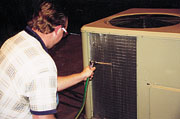Rooftop units have come a long way in recent years. They now contain more sophisticated controls, improved serviceability features, and unique ways to address indoor air quality (IAQ) issues. But even the best-made rooftop can’t keep soldiering on if routine maintenance is not performed regularly.
Some owners may look at preventive maintenance as being too expensive and unnecessary, so it’s up to the contractor to convince them otherwise. Pointing out the long-term benefits of a preventive maintenance program, such as lower energy costs and fewer breakdowns, may convince building owners to sign on.
Fortunately, manufacturers keep redesigning their rooftop units so that performing routine maintenance is much easier.

CREATE A CHECKLIST
There is no set answer to the question of how often a rooftop unit should be maintained. Whether it’s monthly, quarterly, or twice a year depends on the application and location.For instance, a rooftop unit located in an area with a lot of trees or pollution probably needs to be maintained more often than one located in a fairly barren, rural location. And a rooftop unit that runs almost continuously will probably need to be looked at more than one that runs a few hours a day.
That being said, there are general maintenance guidelines. David Boen, technical service engineer for American Standard, Clarksville, TN, notes that proper maintenance of a rooftop unit should include:

Ted Cherubin, senior product manager, Carrier Corp., Syracuse, NY, adds that particularly before summer, contractors should clean out all the fall and winter debris that may have collected in or around the unit(s).
“Take a good visual look at the coils to see if anything is obstructing airflow on the condenser side,” he said. “We also like to have people check the P-trap, as it dries out over the wintertime, can crack,
get plugged, or get completely knocked off. That could cause a problem when the cooling season starts, because it won’t allow it to drain properly.”
Whether or not that maintenance actually occurs depends on a combination of factors. Many contractors see planned maintenance as a way to keep customers loyal and keep service technicians busy in the off-season, when there aren’t as many service calls.
If contractors see the value of regular maintenance, they will educate their customers and employees about its benefits. However, if a contractor sees regular maintenance as a waste of time, then it probably isn’t going to occur.
“Maintenance gives contractors the opportunity to encourage the technician to look closely for problems that can result in breakdowns in summer and winter. An excellent service technician uses routine maintenance as a way of finding problems before they occur — problems that result in breakdowns — providing more benefits for the customer,” says Boen.

BETTER AND EASIER
Many manufacturers have listened to service technicians over the years and, as a result, are designing rooftop units that are much easier to maintain than ever before.For example, Carrier has designed its new units so that it’s not necessary to remove the top of the unit to change the motors or clean the coils. Most manufacturers now have hinged doors, so technicians don’t have to remove 23 screws before accessing the interior. Larger panels and good compressor access also have been incorporated into many rooftop units.
Controls are another area in which manufacturers have made tremendous leaps. “Carrier and other manufacturers are trying to make it much easier for contractors or in-house maintenance staff to know when it’s time to do the maintenance. There are devices now on rooftops that have lights or visual messages that indicate it’s time to change the filters, what the systems pressures are, and if the economizer is operating properly,” says Cherubin. “This aids in determining a pattern for maintenance programs up front or exploits an uncommon occurrence.”
And if it ends up being a service call, manufacturers are ready for that as well. Shawn Wood, packaged product leader, American Standard, notes, “American Standard microcontrols have added better control algorithms and reliability to the process. With some of the added features on these microcontrols, such as built-in test mode and on-board diagnostics, I would have to say that our rooftops are pretty easy to service, especially with practice and proper training.”
Cherubin adds that service technicians are particularly happy with the more advanced controls available on rooftop units — as long as it is not a black box. “Our controls log the alarm history on the unit, and it can be accessed on the unit, remotely, downstairs, or across the country,” he says. “It will basically say at this time, this happened. The technician can get a feel for what has happened in the past and the unit can spell out to him in plain English exactly what’s wrong.”
Beyond troubleshooting, both Cherubin and Boen encourage contractors and service technicians to first listen to the customer. “There may be more than one problem and the customer might provide just the right clue to get to the underlying or secondary problem,” notes Boen.
He adds that the goal of a service technician is to look for the root cause; for example, a burned-out contactor could be caused by not having the transformer on the correct voltage tap. Premature compressor failure could be caused by collapsed ductwork or a plugged evaporator coil. Or, a cracked condenser fan blade could indicate a plugged condenser coil.
“You’re doing a better service for the customer, and also making more money for your own business, by finding the root cause,” stresses Boen. Fortunately, manufacturers are making it easier and easier to track down and fix any of the root causes.
With maintenance programs on the rise, it’s becoming more important to have service technicians voice their opinions on equipment being installed now. Easy access to filters, coils, economizers, condensate pans, and all other airstream devices can help reduce maintenance time and improve unit operation for years to come.
Publication date: 06/24/2002


Report Abusive Comment